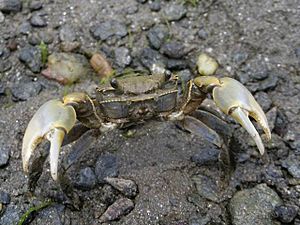Helice tridens facts for kids
Quick facts for kids Helice tridens |
|
|---|---|
 |
|
| Scientific classification | |
| Kingdom: | |
| Phylum: | |
| Subphylum: | |
| Class: | |
| Order: | |
| Infraorder: | |
| Family: |
Varunidae
|
| Genus: |
Helice
|
| Species: |
H. tridens
|
| Binomial name | |
| Helice tridens (De Haan, 1835)
|
|
| Synonyms | |
|
|
Helice tridens is a type of crab that lives in muddy areas. You can find these crabs along the coasts of Japan and the Korean Peninsula.
Life in the Mudflats
This crab is called "semi-terrestrial." This means it spends time both on land and in the water. It goes back to the sea to lay its eggs.
Sometimes, raccoons can be a problem for these crabs. Raccoons are an animal that hunts and eats other animals. They are not native to these areas.
Helice tridens needs a certain amount of salt in the water. It likes water that is saltier than what some other crabs, like Helicana japonica and Chiromantes dehaani, prefer.
Younger crabs hide in burrows in reed marshes. They do this to avoid being eaten by bigger crabs. This is called cannibalism. Older crabs might move to less salty brackish water lagoons in the summer. They do this when there are too many crabs in one place.
How it Got its Name
The crab Helice tridens was first described by a scientist named Wilhem de Haan. He wrote about it in 1835 in a book called Fauna Japonica. At first, he named it Ocypode tridens.
There used to be two types of Helice tridens that were thought to be subspecies. These were H. t. wuana and H. t. sheni. Now, scientists know they are actually a separate species called Helicana wuana.
See also
 In Spanish: Helice tridens para niños
In Spanish: Helice tridens para niños

